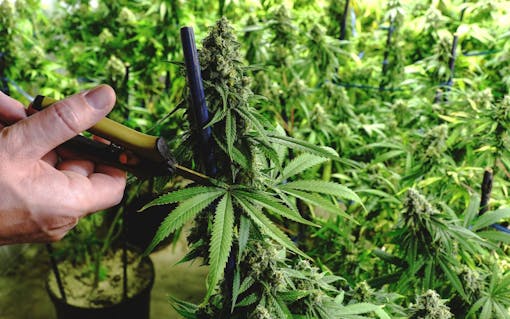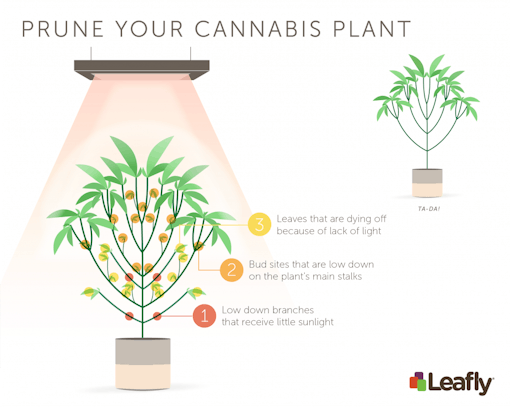
Topping vs. pruning: What is the difference?
The line between topping and pruning can be a little hazy. Topping is cutting off the main stalk of a weed plant to force it to grow more bushy, which will allow it to yield more and be healthier. Pruning is removing marijuana leaves and branches that are dead or won’t receive much light so that a weed plant can focus its energies on producing buds in other areas.
The line between the two is blurred because a lot of times growers do both at the same time. Here’s the differences between the two.
Why is topping marijuana necessary?
Although it may seem strange to cut off and throw away part of your cannabis plants, topping is essential to keep your weed plants healthy and to get quality yields.
If left to grow on its own, a marijuana plant will grow vertically, focusing its energy on one main stalk. The result will be one giant cola at the top with smaller colas on the main stalk. These other colas will be small and larfy and of poor quality. The overall size and yield of the plant will be small.
Topping is done during the vegetative stage to help redistribute growth hormones from the main stalk to side branches—by cutting off the main stalk, the plant will redirect its energies to side branches, forcing them to grow out, instead of up. Topping makes a weed plant bushier.
When to top marijuana plants
Wait until the plant has grown six or seven nodes to do the initial top, which is usually done above the 5th node. It’s important to wait until the plant has developed this much so it can withstand the shock of topping.
Grab some seeds for your grow

“Seed Supreme has a massive selection of strains both common & rare, expertly collated into an easy-to-use web experience.“
– Leafly “Best Value” seed bank pick
We may earn a small commission if you buy through links on this page.
If you wait to top a weed plant after it has developed more than seven nodes, the plant will have been putting energy into upward growth that you are just going to cut off, when it could have been focusing on lateral growth that you will keep.
Shop highly rated dispensaries near you
Showing you dispensaries nearHow a marijuana plant receives light
A bushy shape allows light to hit all branches more evenly—because the cannabis plant is wide and not tall, all bud sites will receive an equal amount of light.
With one vertical stalk, the main cola will get a lot of light, but the lower branches will get shaded out by the main cola, producing larfy buds down below. With a bushy shape, you’ll get more buds, and they’ll be of a higher quality.
In time, these side branches can also get topped, which will create even more side branches and make the plant bush out even more. Doing this will also create more bud sites on branches and therefore increase your yields. Generally, a plant will get topped 1-3 times during its life.
Does topping cannabis plants increase yields?
By topping, a plant will develop more of a bushy shape, which will allow more light to hit more parts of the plant. Without topping, you’ll only get a few large nugs at the very top of the plant and the rest will get shaded out.
How to top marijuana plants
Topping cannabis works best when a plant is strong and developed and can withstand drastic change.
For the first topping—cutting the main stalk—a good rule of thumb is to cut the plant above the 5th node. This will give you enough side branches on the remaining part of the plant for it to bush out properly.
For subsequent toppings on the same cannabis plant, cut each side branch above the second or third node, to allow the plant to continue to bush out properly. These toppings are more subjective however, and will depend on how much you want the plant to bush out and how big you want the final plant to be.
To top marijuana plants:
- Get your tools and disinfect. You’ll need either a pair of pruning scissors or a razor blade. The sharper the better—you want to make one clean cut. The tool should be sterilized with rubbing alcohol to help prevent infections in the plant (this is very rare, but it doesn’t hurt to be safe).
- Decide where to make your cut. Find the 5th node on the main stem, and cut above it.
- Wait and watch. Topping can be stressful for the plant, so keep an eye on it for a couple days and be sure it gets plenty of water and light. If you’re going to top again, give the plant a couple weeks to recover from the first topping.
Topping vs. fimming
Topping marijuana is the tried-and-true method preferred by most growers, but there is another plant training technique called “fimming” or “FIMing”—short for “f**k I missed,” if you’re wondering. Fimming started as an accident but is also useful in the right circumstances.

The difference between topping and fimming is nothing more than the location of where you cut the plant—with fimming, you’ll cut off the upper half of the new growth (see image above). Topping may create two new stalks from where you cut, whereas fimming might create 3-8 new stalks.
Whichever technique you choose, you’ll see an increase in yields. If you aren’t sure which method works best for you, try both and see which you prefer.
How to fim a weed plant
The fimming technique works great for cannabis growers in small spaces who are trying to maximize yields. However, fimmed plants will need more structural support, so take extra care in trellising your garden. Topped plants are more stable and have a stronger branch structure, requiring less support.
Why prune marijuana plants?

As mentioned above, pruning removes cannabis leaves and branches that are dead or won’t receive much light. Again, it might feel strange to intentionally cut off bits of your plant, but without the proper amount of light, buds will be a poor quality.
Cutting off these branches will allow the plant to redirect its energies to the quality buds that will receive plenty of light. You also want to prune off yellow or dead leaves—they have no use and will only waste the plant’s resources.
Pruning also creates open space in the middle of the marijuana plant, allowing air to flow through it more freely and light to penetrate deeper, keeping the plant healthy and vibrant so it can produce more quality buds.
While pruning cannabis, take the opportunity to closely look at your plants and check up on their health, looking for pests, nutrient deficiencies, and soil issues.
When to prune marijuana plants
Check out Johanna’s full video series on how to grow weed on Leafly’s YouTube.
In the early stages of growth, a plant is narrow enough that most of the foliage will receive plenty of sunlight. Top plants to promote bushy growth, and start pruning your plants when they begin to take a bushy shape.
As a plant grows and bushes out, you’ll get a better sense of its overall shape and of the entire canopy. This will give you a sense of where the quality buds will grow so you can prune away the unnecessary parts of the plant. From this point until the beginning of flowering, you can actively prune your plants.
Can you prune during flowering?
Once into the flowering phase, you’ll largely want to cease pruning, as it can diminish the size and quality of your buds. Some light pruning can be done to clean up small bottom branches that won’t get much light, and dead, yellow leaves.
How to prune marijuana plants
To prune cannabis plants:
Grab a pair of pruning shears, usually some Chikamasas or Fiskars, for quick work on small branches and leaves. Also have another pair with more strength nearby to cut larger branches.
Keep your clippers/scissors sharp and make clean snips—this will keep the plant healthy and prevent infection and damage. Quality buds grow where the plant receives a lot of sunlight and airflow, particularly at the top of the plant. You’ll want to:
- Remove large branches first. This will allow you to clear out space before you begin the detailed work. Start with branches on the bottom of the plant. These won’t receive enough sunlight and will never become fully developed buds.
- Cut off branches that will get shaded out. This can include branches in the middle of the plant or others that won’t get light, depending on your setup and if you use a trellis or scrog.
- Prune any small or dying branches or leaves.
What to do after pruning or topping your plants
Pruning, and especially topping, can be a bit of a shock for a plant. In the days following a pruning or topping, make sure your plants have plenty of light and water. They should experience a burst of growth—the open space will allow extra light to get to the plant.
Trevor Hennings contributed to this article.
Edited by Pat Goggins
Read more of Leafly’s guide to growing marijuana
- How to grow weed: Basics of growing marijuana
- 4 stages of marijuana plant growth
- Marijuana plant anatomy
- How much weed can you get from growing one plant?
- How to grow weed indoors
- How to grow marijuana outdoors
- How to set up an indoor weed homegrow for under $500
- Top 6 weed strains to grow indoors
- Cannabis seeds 101: How to grow marijuana from seed
- How to clone cannabis plants
- Marijuana seedling and plant care
- How to top and prune marijuana plants
- How to scrog marijuana plants
- How and when to transplant cannabis plants
- How to harvest marijuana plants
- How to trim marijuana
- How to dry and cure cannabis
- Troubleshooting common cannabis plant problems
- Marijuana plant nutrient deficiencies
- Buyer’s guides for cannabis seeds and growing equipment
Ready to start growing your own marijuana?
Buy marijuana seeds on Leafly.
By providing us with your email address, you agree to Leafly's Terms of Service and Privacy Policy.